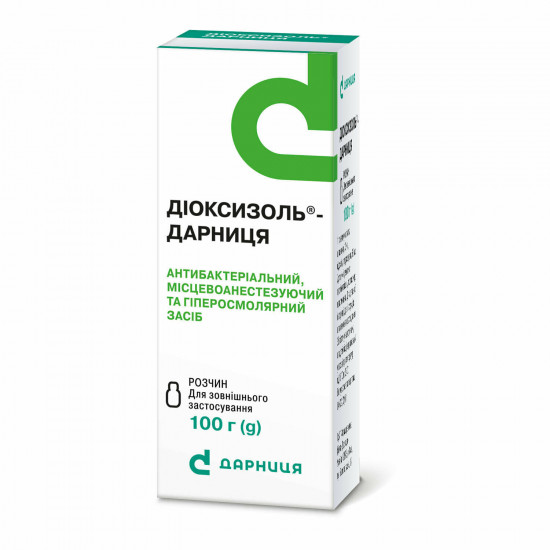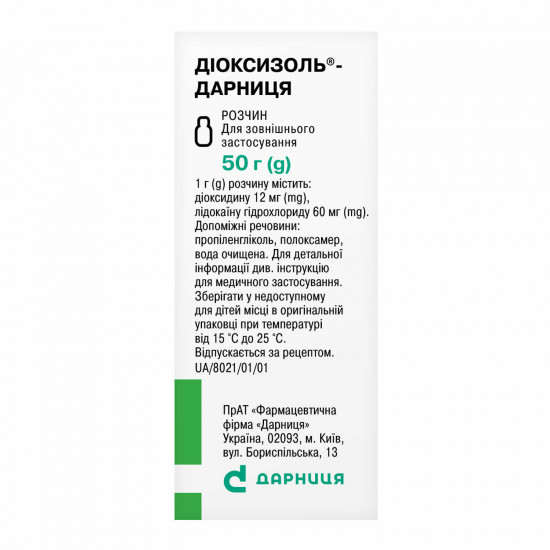



- Stock: In Stock
- Model: 179485
0% Customers recommend this product
-
5 Awesome0%
-
4 Great0%
-
3 Average0%
-
2 Bad0%
-
1 Poor0%
Reviews Over Dioksizol-Darnitsa solution fl. 100 g
- (0)
Total Reviews (0)
click here write review to add review for this product.
Report this review.
Description
Pharmacological properties
Pharmacodynamics
Drug dioxysol of darniyets — the combined medicine for topical administration which active ingredients are the dioxidin and lidocaine. solution has strong mestnoanesteziruyushchy and moderate giperosmolyarny effect, stops wound and perifocal inflammation, stimulates processes of a reparation and activity of phagocytes in a wound.
Dioxidin has the expressed antibacterial effect concerning gram-negative and gram-positive, aerobic and anaerobic, spore-forming and asporogenic microflora (a pyocyanic stick, stafilokokk, streptococci, clostridiums, bacteroids, peptokokk, etc.) in the form of monocultures and microbic associations, including hospital strains of bacteria with polyresistance to other antibacterial drugs. The ability to damage DNA of bacteria is the cornerstone of its antibacterial action. As a result of such influence the synthesis of bacterial nucleases slows down, the ultrastructure of a bacterial cell is broken, there is a thickening of a cellular cover and violation of structure of membranes. Cytostatic action is caused by influence on sites of a genome responsible for synthesis of the exoenzymes causing virulence what the ability of medicine to interfere with development of resistance in microorganisms is connected with.
Lidokain has the mestnoanesteziruyushchy effect caused by blockade of potentsialzavisimy Na + - channels that interferes with generation of impulses in the terminations of sensory nerves and to carrying out impulses on nerve fibrils. At topical administration expands vessels, has no local effect. The effect develops in 1–5 min. after drawing on skin.
PharmacokineticsDioxidin at topical administration is practically not soaked up by
and has no local irritative effect. In an organism it is not metabolized, does not kumulirut. It is allocated with kidneys.
Speed of absorption of lidocaine and amount of active agent which gets to a blood-groove depend on a dose, type, the size and a condition of a surface on which apply medicine (skin or a mucous membrane) and also exposure durations.
Lidokain is well soaked up bywhen drawing on a mucous membrane and the injured skin and it is bad — when drawing on healthy skin. Time of achievement of the C max in blood plasma — up to 1 h. 40–80% of lidocaine contact proteins of blood plasma. Gets through hematoencephalic and placentary barriers, into breast milk. It is metabolized in a liver. T ½ — 1.6 h. It is allocated with kidneys and with bile: 90–95% — in the form of metabolites, 10% — in not changed look.
Indication
Topical treatment of contaminated wounds of soft tissues of various localization and genesis (extremity stumps after amputation, wounds after surgical treatment of suppurative focuses, decubituses, trophic ulcers; purulent postoperative wounds and fistulas; paraproctitis, abscess; phlegmons of maxillofacial area, etc.), treatment of burns of the II-IV degree, chronic and sharp osteomyelitis, preparation of a wound for an autodermoplastika, prevention of pyoinflammatory processes in surgery and Combustiology when performing various plastic surgeries.
Use
Drug is used at adults locally and for introduction to fistulas, wound cavities and pockets.
Topical administration. Before a course of treatment it is necessary to carry out skin allergy test (on the internal surface of a forearm, subcutaneously) on tolerance of medicine. In case of positive reaction not to apply solution.
to use Drug directly after surgical treatment of wounds and burns and also further in the course of their treatment, previously cleaning a wound surface from exudate and necrotic fabrics. It is plentiful to saturate a sterile dressing material (gauze bandages or tampons) with solution and to apply on superficial burns or to enter into deep wounds then to impose sterile napkins which fix bandage or an adhesive plaster. To change bandages at treatment of burns of 1 times in 7–14 days, at treatment of wounds — 1 time a day.
Intracavitary introduction (fistulas, wound cavities and pockets). Before a course of treatment to carry out test on tolerance of medicine for what to enter 8 ml into a purulent cavity. At absence during 3–6 h side reactions (dizziness, a fever, fervescence) to begin course treatment.
to administer the Drug a catheter by means of the syringe 1–2 times a day with the subsequent imposing of a sterile gauze bandage.
Dose and duration of treatment depend on the sizes of the damaged site, disease severity, shipping and are defined by the doctor. At the same time the daily dose of solution at topical administration should not exceed 100 ml, at introduction to cavities — 50–60 ml. The course of treatment should not exceed 15 days.
Contraindication
Hypersensitivity to medicine components. arterial hypotension, cardiogenic shock, av-blockade of the II-III degree, bradycardia, insufficiency of bark of adrenal glands (including in the anamnesis).
Side effects
from the immune system, leather and hypodermic cellulose: reactions of hypersensitivity, in particular an itch, a dermahemia, rash, urticaria, near-wound dermatitis, hypostases, pain and burning in the site of application, disappearing independently in a few minutes and not demanding medicament withdrawals.
At intracavitary introduction of medicine or when exceeding doses the development of the system side effects caused by existence in dioxidin medicament is possible: headache, dispeptic disorders, fever, fervescence, spasms, reactions of hypersensitivity, photosensitization.
System side reactions at use of lidocaine as local anesthetic arise very seldom. Application of too high doses (more than 15 g) of lidocaine, fast absorption of medicine, hypersensitivity, an idiosyncrasy or the lowered tolerance to lidocaine at some persons can be the cause of their emergence. System side effects can be shown by excitement or oppression of central nervous system, oppression of a cardiovascular system against the background of arterial hypotension, bradycardia and an anaphylaxis, spasms, a tremor.
Special instructions
use Drug under observation of the doctor. before application it is necessary to carry out test on tolerance of medicine. in case of positive reaction not to apply solution. with care appoint medicine to patients with an abnormal liver function and the patient with a renal failure.
At emergence of side reactions should lower a dose, to appoint antihistaminic medicines, and if necessary — to stop use of medicine.
Drug is used mainly in the first phase of wound process and also in the second — at the granulating wounds, with zones of necrosis and inflammation.
Use during pregnancy and feeding by a breast. Drug is contraindicated during pregnancy.
Children. Drug is not used at children.
Ability to influence the speed of reactions at control of vehicles or work with other mechanisms. During treatment it is necessary to refrain from control of transport and potentially dangerous types of activity which require special attention and also the speed of mental and motor reactions.
byInteraction
Interaction of solution dioxysol-darnitsa with other medicines it is not revealed, however it is not recommended to apply it along with other ointments or creams.
Overdosein case of overdose strengthening of side effects of medicine is possible
.
Treatment: medicament withdrawal, symptomatic therapy.
Storage conditions
In original packing at a temperature of 15-25 °C.
Specifications
| Characteristics | |
| Active ingredients | Dioxidin, Lidocaine hydrochloride |
| Applicant | Darnitsa |
| Code of automatic telephone exchange | J01XX Other antibacterial agents |
| Interaction with food | It doesn't matter |
| Light sensitivity | Not sensitive |
| Market status | Traditional |
| Origin | Chemical |
| Prescription status | According to the prescription |
| Primary packing | bottle |
| Producer | DARNITSA CIAO PHARMACEUTICAL. FIRM |
| Quantity in packing | 100 g |
| Release form | solution for external use |
| Route of administration | External |
| Sign | Domestic |
| Storage temperature | from 15 °C to 25 °C |
| Trade name | Dioksizol |














































